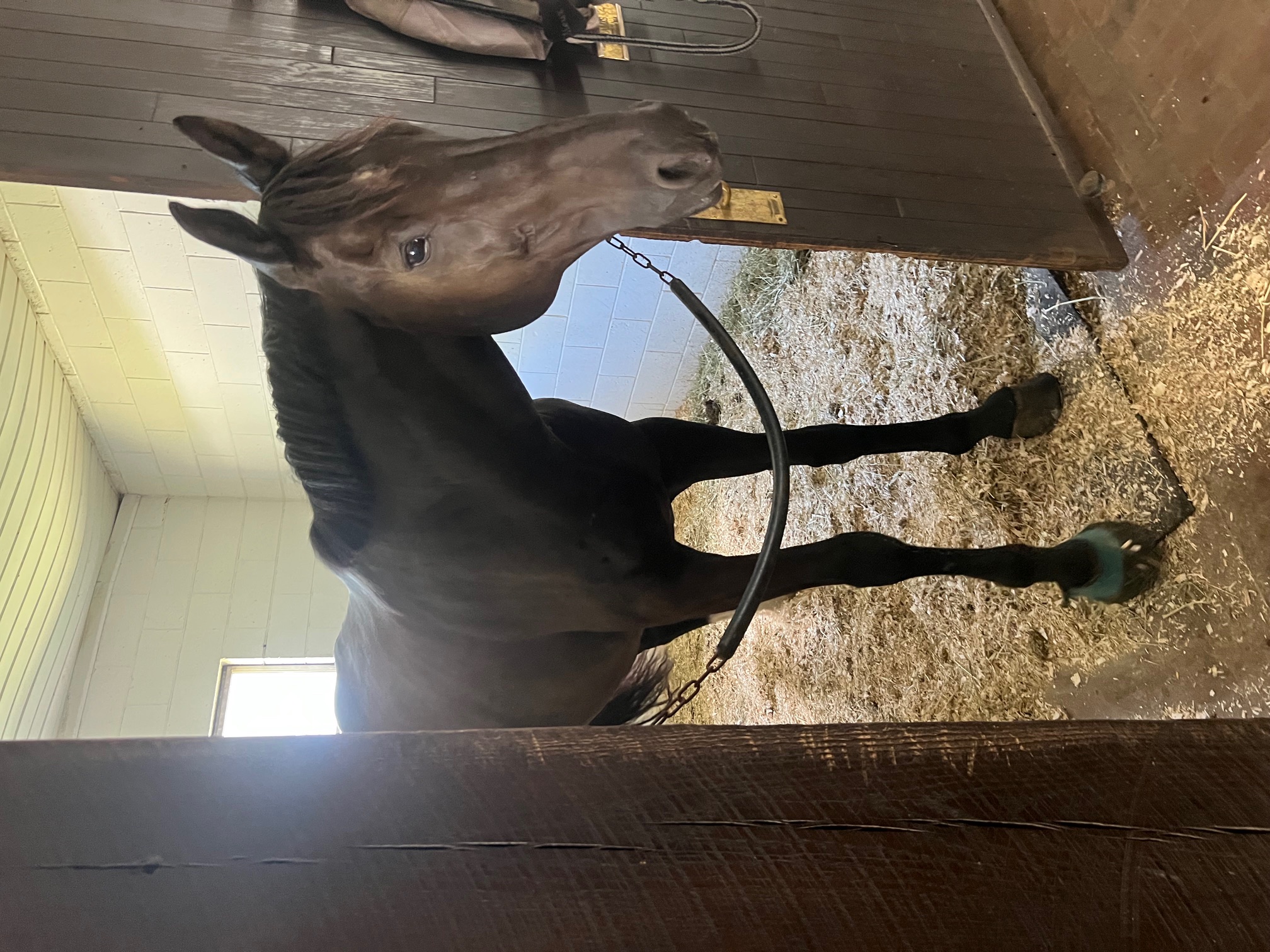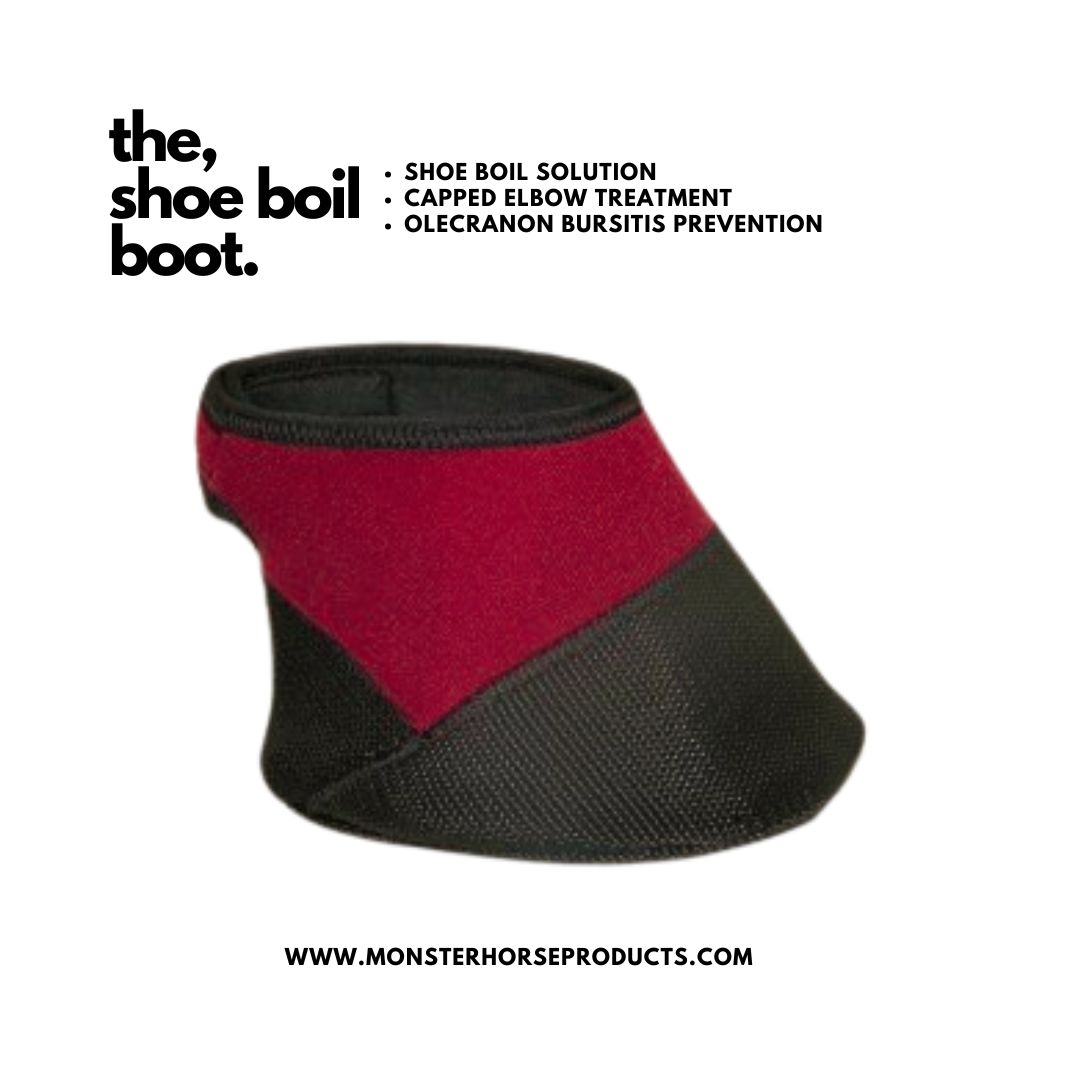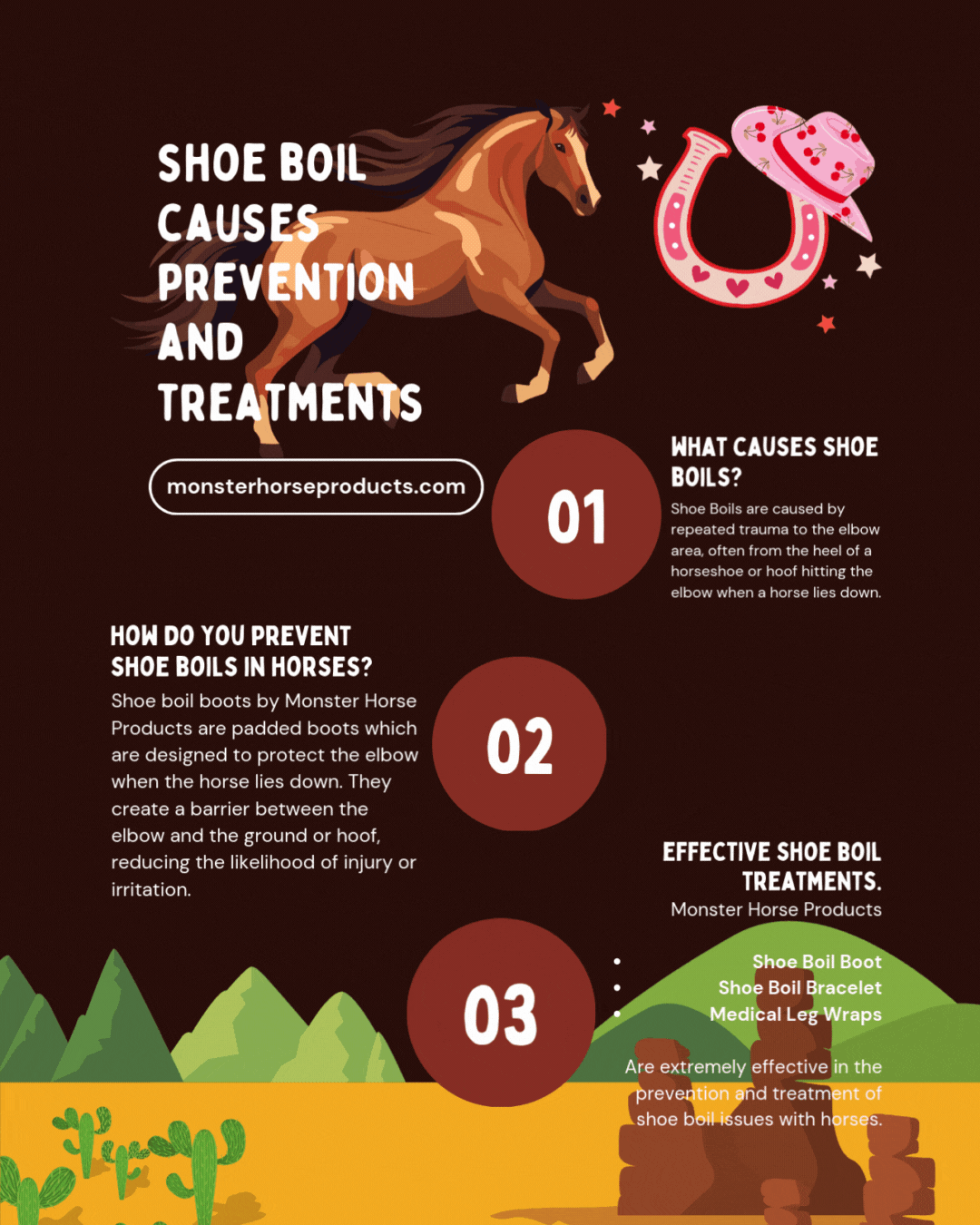Healthy Hooves & Beyond
Monster Featured Friends

Aramis says thank you for the boot.
It fits like a glove, he loves wearing it and the shoe boil is looking under control.
We appreciate all your help Kim.
- Lidiya and Aramis
Tewksbury NJ
Real-World Insight from the Barn
Shoe boils, medically known as olecranon bursitis, are more common in horses than many owners realize. While they may seem like a minor issue at first, these fluid-filled swellings on the horse’s elbow can lead to persistent discomfort and long-term complications if not addressed properly.
Let’s explore what causes shoe boils, how to treat them effectively, and the best preventative measures—so you can keep your horse comfortable, healthy, and ready for the arena or trail.
What Exactly Is a Shoe Boil?
A shoe boil occurs when repeated pressure or trauma to a horse’s elbow joint—often from lying down or contact with their hoof or shoe—causes inflammation of the bursa, a fluid-filled sac near the joint. This results in swelling, heat, and sometimes pain.
These can develop overnight, especially in horses with long-heeled shoes or those kept on hard surfaces with minimal bedding.
The Truth About Shoe Boils and How To Prevent Them
Unlock The Magic Of The Shoe Boil Bracelet
Snag The Legendary Shoe Boil Boot at Monster Horse Products
What Causes Shoe Boils in Horses?
-
Long-heeled horseshoes creating friction during rest
-
Hard stall flooring with insufficient bedding
-
Frequent lying down or injury during rolling
-
Poorly fitted tack or conformation issues
Treatment Options for Shoe Boils
1. Preventing Further Trauma
The first and most important step in shoe boil treatment is preventing additional irritation to the elbow area.
-
Increase Bedding: Adding deep, soft bedding helps cushion your horse’s joints while lying down.
-
Use a Shoe Boil Boot: Shoe boil boots (also known as donut boots) wrap around the pastern to keep the hoof from contacting the elbow. They’re one of the most effective tools in your toolkit.
-
Shoe Modifications: Consult your farrier to adjust or shorten long heels, which can aggravate the elbow when the horse rests.
2. Reducing Inflammation and Pain
Inflammation is the body’s natural response—but it can prolong healing if left unmanaged.
-
Rest: Give your horse time off from training or pasture work.
-
Cold Therapy: Cold compresses or hydrotherapy sessions can reduce swelling.
-
Anti-Inflammatory Medications: Drugs like Bute or Banamine are often prescribed to ease pain and swelling.
-
Corticosteroid Injections: In severe cases, a vet might aspirate the fluid and inject a steroid to shrink inflammation.

3. Addressing Underlying Causes
If your horse keeps developing shoe boils, it’s time to look at long-term prevention.
-
Stall Management: Keep bedding dry, clean, and consistently deep.
-
Proper Shoeing: Work closely with a knowledgeable farrier who understands how shoe length and shape affect elbow contact.
-
Veterinary Intervention: In recurring or serious cases, vets may recommend draining the bursa or using cautery to prevent future inflammation.
Important Considerations for Horse Owners
-
Early treatment = faster recovery
-
Monitor for signs of infection like heat, redness, or drainage
-
Never ignore chronic elbow swelling—it may lead to permanent joint issues
Shoe boils often heal naturally once pressure is removed—but recurrence is common. Prevention and long-term elbow care should be part of your regular horse health routine.
Real-World Insight from the Barn
At Monster Horse Products, we’ve treated hundreds of cases with our shoe boil boots, wraps, and bracelets. Based on years of hands-on experience, we've found that combining boot use with proper bedding is the most effective long-term strategy.
Learn more from our related articles:
Get the Best Shoe Boil Solutions Now
Looking for a proven shoe boil treatment for horses? Our custom-designed Shoe Boil Boots and medical wraps offer unmatched support and protection. Whether you're dealing with a single case or ongoing elbow issues, Monster Horse Products has the gear to keep your horse at peak performance.
Final Thoughts
Horse owners everywhere—from top show competitors to casual trail riders—face the challenge of elbow-related injuries like shoe boils and capped elbows. But with a little knowledge, the right tools, and trusted products, these conditions are highly manageable.
Don't wait for pain to sideline your horse. Take action now and give them the comfort and freedom they deserve!
shoe boil boot, shoe boil boots, capped elbow treatment, olecranon bursitis in horses, capped elbow in horses, shoe boil solution, shoe boil treatment, shoe boils, shoe boil treatment for horses, shoe boil olecranon bursitis, shoe boil solutions, shoe boil treatments
Unraveling the Origins and Legacy of Equines in North America
The majestic horse—an emblem of freedom, strength, and partnership—has galloped through the annals of American history, leaving indelible hoofprints on its cultural and physical landscapes. But are horses truly native to America? The answer is both fascinating and complex.
The Ancient Roots: Horses Evolved in North America
Horses first evolved in North America around 55 million years ago. Early ancestors like Eohippus, a small, forest-dwelling creature, marked the beginning of this lineage. Over millions of years, these equines adapted to changing climates and terrains, eventually developing into larger, grassland-grazing species. By the late Pleistocene epoch, modern horses (Equus caballus) roamed the continent in vast herds, playing a crucial role in shaping ecosystems through grazing and seed dispersal. (American Wild Horse Conservancy)
However, approximately 10,000 years ago, horses mysteriously vanished from North America. Theories abound, ranging from climate change to overhunting by humans. This extinction left the continent horse-free until their reintroduction thousands of years later. (Wikipedia)
The Return: Reintroduction by Europeans
The horse made its triumphant return to North America with the arrival of Spanish explorers in the late 15th and early 16th centuries. Christopher Columbus brought horses to the Caribbean in 1493, and Hernán Cortés introduced them to the mainland in 1519. These Iberian horses, often referred to as "Spanish type," quickly spread throughout the continent. (Wikipedia)
Native American tribes rapidly adopted the horse, integrating it into their cultures and transforming their ways of life. The Comanche, for instance, became renowned horsemen, utilizing horses for hunting, warfare, and transportation. The horse's reintroduction had a profound impact, reshaping societies and economies across the Americas. (Wikipedia, Brooke USA)

The Debate: Native or Non-Native?
Despite their ancient origins in North America, modern wild horses are often labeled as non-native or even invasive species by federal and state agencies. This classification has significant implications for their management and conservation. (Animal Welfare Institute)
However, recent scientific research challenges this perspective. Genetic studies confirm that horses were part of North America's fauna for hundreds of thousands of years before their extinction. The feral horses that roam the American West today are descendants of those reintroduced by Europeans but carry the legacy of their ancient ancestors. (American Wild Horse Conservancy)
The Modern Horse: From Work to Companionship
In the centuries following their reintroduction, horses became integral to American life. They plowed fields, transported goods, and served as essential companions in both rural and urban settings. With the advent of mechanization in the 20th century, the role of horses shifted predominantly to recreation, sport, and companionship. (Wikipedia)
Today, horses continue to captivate us, not only as symbols of the American spirit but also as partners in various equestrian disciplines. Their care and well-being remain paramount, leading to advancements in equine health and safety products.
Promoting Equine Health: Insights from Monster Horse Products
At Monster Horse Products, we understand the deep bond between humans and horses. Our commitment to equine health is reflected in our range of products designed to address common issues and enhance the quality of life for these noble animals.
For instance, our Shoe Boil Boot offers an effective solution for preventing and treating capped elbow in horses. This condition, often resulting from repeated trauma, can lead to olecranon bursitis if left unaddressed. Our boot provides cushioning and protection, promoting healing and preventing further injury.
Additionally, our Medical Wraps and Shoe Boil Bracelet are designed to support joint health and prevent common ailments. These products are the culmination of extensive research and a deep understanding of equine anatomy and needs.
For more insights into equine care and the history of horses in America, explore our blog, where we delve into topics ranging from the evolution of horse domestication to modern equine health challenges.
📚 Further Reading and Resources
-
Scientific Research Confirms Native Ancestry of America's Wild Horses
-
Horses part of Indigenous cultures longer than Western historians thought
Conclusion
So, are horses native to America? In the grand tapestry of evolutionary history, they are. Horses originated and evolved on this continent, only to disappear and later return with human help. Their story is one of resilience, adaptation, and enduring partnership with humans.(Wikipedia)
At Monster Horse Products, we're honored to be part of this ongoing journey, providing solutions that uphold the health and well-being of horses across the nation. Together, we continue to celebrate and care for these remarkable creatures that have galloped alongside us through the ages.
What Are Shoe Boils in Horses?
Shoe boils, also known as olecranon bursitis or capped elbow, are painful swellings that form on a horse’s elbow. These lumps occur when the bursa (a fluid-filled sac) becomes irritated due to repeated trauma or pressure. Commonly caused by the horse lying on hard surfaces, shoe boils can cause discomfort and affect movement, especially if left untreated.
How to Prevent Shoe Boils in Horses
Preventing shoe boils requires proactive measures to reduce pressure and trauma on the elbows. Here are the most effective ways to prevent them:
-
Use Shoe Boil Boots
Shoe boil boots provide cushion and protection around the horse’s elbows when lying down, reducing the risk of developing shoe boils. -
Ensure Soft Bedding
Providing soft, deep bedding will help cushion the horse’s elbows while they rest. This can minimize pressure on sensitive areas and prevent trauma. -
Check for Early Signs
Regularly check the horse’s elbows for swelling or redness. Catching the problem early can make treatment easier and prevent further damage.
How to Treat Shoe Boils in Horses
If your horse develops a shoe boil, prompt treatment is essential to prevent discomfort and further complications. Here are the common treatment options:
-
Rest
Giving your horse time to rest is crucial for healing. Limiting movement allows the bursa to heal and reduces further irritation. -
Cold Therapy
Applying cold therapy, such as ice packs, can help reduce swelling and inflammation in the affected area. -
Fluid Drainage and Injections
If swelling persists, your veterinarian may drain the fluid from the bursa and administer corticosteroid injections to reduce inflammation. -
Surgical Intervention
In severe cases, surgery may be necessary to remove the bursa or correct deformities that cause persistent pressure.
Top Products for Preventing Shoe Boils
To effectively prevent and treat shoe boils, consider using the following products:
-
Monster Horse Shoe Boil Boots
These padded boots offer protection against pressure, especially when your horse lies down. -
Cold Therapy Poultices
Products like the Kool-Out™ Poultice are excellent for reducing inflammation and soothing the affected area. -
Soft Bedding Products
Invest in high-quality, soft bedding that provides extra cushioning to your horse’s resting area.

FAQs About Shoe Boils in Horses
What Causes Shoe Boils in Horses?
Shoe boils are caused by repeated pressure or trauma to the horse’s elbow. Horses lying on hard surfaces or having poor bedding are at a higher risk.
Can Shoe Boils Be Prevented?
Yes, by using protective boots, ensuring soft bedding, and regularly checking for early signs, you can prevent shoe boils from developing.
How Long Does It Take for a Shoe Boil to Heal?
Healing time depends on the severity of the shoe boil. With proper treatment, it can take anywhere from a few weeks to a couple of months for complete recovery.
Conclusion
Shoe boils are a common yet treatable condition in horses, but taking steps to prevent them is the best approach. With products like shoe boil boots, soft bedding, and early intervention, you can keep your horse comfortable and reduce the risk of developing this painful condition. If shoe boils do occur, quick treatment with rest, cold therapy, or veterinary intervention will help your horse recover faster.
